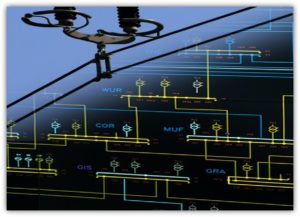SCADA in Electric Power Utilities
Data Acquisition and Processing
SCADA system receives all process data from
- Remote Terminal Units
- IED
- Automation systems
- Smart Grid components
Standard communication protocols are used. The sources are connected to the SCADA system system using communication systems.
- Information is entering the SCADA system system processing by:
- Process Interfaces (i.e. Telecontrol Gateways, TCP/IP Gateways)
- Routers (e.g. ICCP) or
- User interface by manual entry.
The protocols used are handled by the components above in cooperation with an Interface Computer Systems. OSI layers 1 to 6 are managed by the process interfaces (front-ends), layer 7 by the Interface Computer Systems.
Normally, the front end components terminate the connection to the RTUs (or data concentrators) and work additionally as proxy servers.
For telecontrol protocols the supported standard methods of data acquisition are:
- Polling/scanning.
- Unsolicited reporting
- Reporting by exception
Sequence of Events Data
In an electricity SCADA system, sequence of Events data can be processed according to different strategies, depending on the communication system and telecontrol protocol used.
The real-time tagged message can be received:
- As the only information (only the real-time stamped data is sent)
- In addition to a non-time tagged telegram with a lower priority (“sent twice”)
- As a file stored in the RTU comprising one or more events (SOE files).
Supervisory Control and Commands
SCADA system shall provide the necessary functions for remote controlling (i.e. to switch or adjust) any equipment installed in the field, which have a direct or indirect telecontrol link to the control center.
For those operations SCADA system provides commands for
- Switching operations (ON/OFF)
- Incremental stepwise control (RAISE/LOWER)
- Incremental continuous control, (RAISE/LOWER/STOP)
- Setpoint control.
SCADA system supports single as well as double bit commands. Handling may depend on the telecontrol protocol used.
Commands can be parameterized either as
- Direct commands, or as
- Check-Back-Before-Execute.
Switching in the process may be carried out only by authorized personnel at authorized locations. Additionally only such operations may be carried out which are in accordance with the company as well as the general rules of electrical engineering.
SCADA system checks all operations for their
Switching in the process may be carried out only by authorized personnel at authorized locations. Additionally only such operations may be carried out which are in accordance with the company as well as the general rules of electrical engineering.
SCADA system checks all operations for their permissibility. Such checks are implemented in the Interlocking Functionality of SCADA system.
. Such checks are implemented in the Interlocking Functionality of SCADA system.
Connectivity Analysis
Connectivity analysis is one of the foundations of modern SCADA systems. It is the basic function for network coloring as well as for many functions such like the interlock checking (control permissive) or network calculation applications (power flow, short circuit calculation, etc.).
Post Mortem
The Post-Mortem Analysis is the operator's tool to carry out an after-the-fact analysis. It logs all events from the process as well as from the control system and allows replaying them. It is an extremely powerful tool for the operators and management.

Switching Programs
Topolgy Based Operations

